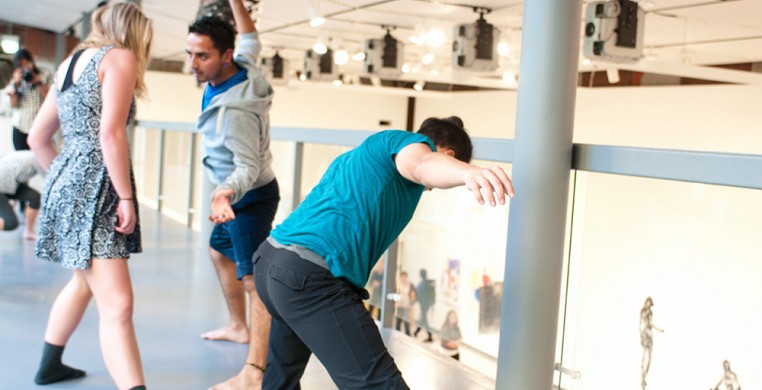Tomorrow, Tuesday, October 29th, our next Moving Dialog – Body As Source, will occur at The Dance Center of Columbia College Chicago…below are reflections from our first fall event – Crossover.
For Crossover, our first fall Moving Dialog at Hyde Park Art Center[HPAC], the work/explorations of Tony Orrico, Susan Marshall and Anthony Romero, invited both observations and conversations that allowed for opportunity to discuss what we deem as movement, visual art and performance.
It was indeed multiple observations that occurred on that Monday, September 16th as part of HPAC’s ArtBar; as those who attended bore witness to the intersections of the visual art on display at Hyde Park Art Center, the temporary video installation of Susan Marshall, Anthony Romero’s experiment with Dance Center and Photography students of Columbia College, and the falls & rises of Tony Orrico’s kinetic live drawing.
Performative and visual movements travelled and were placed throughout the expanse of this art center, igniting many small conversations; some stirred by confusion as to whether they should pass through the dancers on the upstairs ‘catwalk’ or trying to understand the interaction of the photography students capturing images of this movement. These images of the photographers were then taken to pop-up photo lab and displayed immediately. But what about the choreography of the photographers? were they a distraction or part of the work itself? These questions were ones attendees grappled with…
On the lower level others engaged, interacted with Susan’s Stop video, on loop in the transformed multipurpose room; either by taking in the striking video duet of the women dancers commanding our attention, or embraced an “in-the-moment” learning of their choreographed gestural moves boldly coexisting alongside the sonic composition of David Lang.
As the dancers’ moves upstairs subsided, attendees proceeded to the far end gallery to experience Tony Orrico’s cascading work Waning. Hearing the thump of Tony’s falling body against the unforgiving floor surface awoken more conversations, and empathetic responses. “Ouch”, is he going to…? yes, he is…” Again and again, Tony fell and rose, with drawing utensil in hand; sketching out this kinetic cycling for the duration of the piece.
Close to 60 minutes later, after migrations through the various gallery spaces and entryways, we gathered in the lower level large open gallery to exchange thoughts and queries regarding the three artist entities’ works. Inside a circle-like formation of chairs, we first shared overall impressions. Many suggested how the kinetic movement of all three works made them aware of the non-kinetic or visual work on the walls. “It was like the dancing activated the visual work in a way…” was one comment. On speaking on Anthony’s experiment with the students [a collaboration with Columbia College professors and staff Lisa Gonzalez, Peter Fitzpatrick and Laura Bauknecht], people questioned the photography students’ interaction with the dancers upstairs. A frustration with the interaction, as if it got in the way of the movement or seeing the dance. i wonder what would have been the sensation if people thought that the photographers were not just capturing the movement, but were part of the work? A “choreography of the photographers”?
Then there was talk of Susan’s video…and discussion of who wished to share a gesture they remembered from the video? A bend of elbow looking up or hand to heart gesture came alive… Susan wanted to hear reflections on what it meant to embody the work? people responded to the notion of observing others embodying the work, the voyeuristic nature of that…and of feeling empowered to try the moves. In general, a thoughtfulness permeated the dialog; accentuated by Susan’s earnest interest in hearing everyone express how the video’s magnified presence impacted them in one way or another.
And Tony. people were mesmerized by his cycle of falls and the way it impressed upon the paper. the impressions of his kinetic impressions. the dance practitioners in the room remarked on the impact of his fall; how he must have been a dancer in order to continually do that. But what did his dance background have to do with this work? everything! Tony, having worked with the legendary Trisha Brown Dance Company for a period of his career, sure knows how to release, fall and recover. With the grace of his moves, the impressions, etchings he created on paper, seem to signify the visual markings of a dancer’s practice. the cycles of a rehearsal perhaps; the rigor of getting it right. or just allowing one’s self to be in the moment. To Tony it is the work itself. The process of creating it is as valuable as the manifestation. This particular piece has a continued step that he calls “decaying”, that will further realize its visual presence.
What is hybrid? Intercultural? Interdisciplinary? By the end of our communal dialog, these terms were tossed into the space. Did we have a better understanding of them after what we witnessed? perhaps. Not everyone. But all in all, the attendees who were part of this experience, did have the opportunity to discover how movement and visual art can crossover in compelling ways.
Moving Dialogs: Crossover event on Monday, September 16th, featured MacArthur Genius grant recipient Susan Marshall alongside locally-based artists Anthony Romero andTony Orrico at the Hyde Park Art Center[HPAC] as part of their ArtBar series. It was co-presented with the Hyde Park Art Center and The Dance Center of Columbia College Chicago with support from The Photography Department of Columbia College Chicago.
![]()

